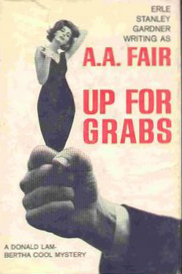Up for Grabs by A. A. Fair (aka Erle Stanley Gardner)
The PI team of Bertha Cool and Donald Lam resemble the comedy team of Stan Laurel and Oliver “Babe” Hardy. Bertha Cool, like Hardy, is irascible, easily driven to distraction by her partner’s antics.
There’s an important difference, however, between Bertha and Babe. Oliver Hardy sagely observed of his character, “He’s the worst kind of dumb guy. He’s the dumb guy that thinks he’s smart.” Bertha may be a lot of things – ham-handed, hard-charging, overly fond of barnyard epithets and old-fashioned (even for 1964) expressions like “Pickle me for a beet.” But one thing she is not, is dumb. Her canny observations cut to the pith of the investigation.
On the surface, Donald Lam resembles Stan Laurel. Both are short and slight. But bright Donald stands in contrast to dim-bulb Stanley. Bertha praises Donald with, “He’s a little runt, but he’s brainy.” As a disbarred lawyer, Donald knows the law well enough to bend it, and the cops enough to send them into conniptions by making evidence twist like a tornado.
Erle Stanley Gardner goes against stereotype by making Bertha the shrewd one and Donald the intuitive one. Materialist Bertha is always distracted by the prospect of big client fees while subtle Donald inevitably senses that the client is not on the up and up, or that something is screwy about a situation. The game afoot is usually a scheme in the grey area between the unethical and the illegal.
Describing the involved plot in this review will dilute the pleasure of surprise for the reader, so I won’t go there. Suffice to say, an insurance executive hires Lam and Cool to catch out malingers who file false claims of injury and disability. Lam flies to Tucson and Dallas to solve the case. He also spends time at a guest ranch in Arizona, in which the desert makes Gardner’s mundane writing as pretty as it ever gets (see also the descriptions of Nevada landscape in Spill the Jackpot!). The exec’s elaborate plan goes by the board, when murder enters the picture.
The mystery plot is not the main attraction. The enjoyment is in watching Donald get in and out trouble with the crooks, the clients, the cops, and crabby Bertha. The complexity of the plots showcases how ingeniously con artists cook up scams and how adroitly Donald can think on his feet and talk his way out of jams. True, Donald Lam, unlike PI Lew Archer or Archie in Nero Wolfe stories, never tells us readers what he is thinking so we have to take his leaps of logic and stunning insight on faith.
Getting to the resolution adds to the fun, even as we shake our heads in bewilderment at Gardner’s endless inventiveness in devising swindles and twisting plots. Gardner’s prose is necessarily concise and plain so the convolutions of the plot won’t confound us alert readers to the point of exasperation. But who needs puzzles or amazing reveals when the characters are so much fun to hang out with?








